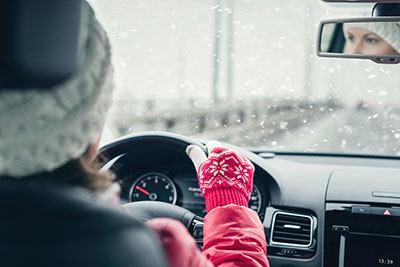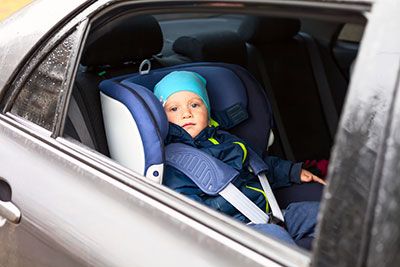As winter approaches and snowflakes blanket the roads, driving safety becomes even more critical.
With school back in session and busy mornings full of holiday activities, parents need to ensure their family's safe arrival wherever they're headed on snow-covered roads.
To ensure you stay ahead of winter's icy grip on your travels, we've created a comprehensive guide outlining the best winter driving safety tips for drivers and parents in 2023.
This guide provides up-to-date tips and tricks from experienced drivers, so your car is ready for anything Mother Nature sends its way.
More...
Take Away Key Points:
How to prepare your car for safe winter driving?

1. Tire check
Winter tires, also known as snow tires, are the best for driving in winter conditions. They're designed with a particular tread pattern and rubber compound, providing better traction on snow and ice-covered roads.
Winter tires have deeper grooves, more biting edges to help grip the road surface, and softer rubber that remains pliable in cold temperatures. During winter, tire pressure drops significantly, so you must check it frequently. Also, remember to keep a spare tire in the back!
All-season tires can also be used for winter driving, but they may not offer the same level of performance as dedicated winter tires in icy and snowy conditions. Therefore, you must check your local regulations regarding winter tire usage to ensure you follow any mandated requirements and that your tires grip well.
Here are some tips on preparing your tires for winter drives:
- Inspect the tread depth: Tires need adequate tread depth to maintain traction on slippery roads. You can use a tread depth gauge or the penny test to determine if your tires need replacing.
- Check the tire pressure: Cold weather can cause a drop in tire pressure, so it's essential to check that your tires have the correct pressure before you hit the road and are properly inflated.
- Check for damage: Look for cuts, punctures, or other signs of damage on all four tires. If you notice any issues, take your vehicle to a professional for repairs.
2. Prioritize vehicle maintenance
Vehicle maintenance is important for winter driving conditions because cold weather and snowy conditions can put extra stress on your vehicle's systems. Here are some reasons why:
- Visibility: Winter weather can cause decreased visibility due to snow and ice, sleet, or fog. Properly working headlights, taillights, and windshield wipers are essential for safe driving in these conditions.
- Traction: Slippery roads can make maintaining control of your vehicle difficult. Regular maintenance of your tires, brakes, and suspension can help ensure good traction on the road.
- Clear the exhaust pipe: Ensure snow, ice, or mud isn't obstructing the exhaust pipe. When clogged, this can lead to fatal carbon monoxide gas entering your vehicle while driving - so remember to check your exhaust system regularly!
- Battery power: Cold temperatures can cause your battery to lose its charge more quickly, so checking it before winter sets in is important.
- Heating system: Your heating system is crucial for keeping you warm and comfortable during cold weather driving. Regular maintenance ensures that it's functioning correctly.
- Fluids: Cold temperatures can also cause fluids like oil and cooling systems to thicken or freeze, which can cause damage to your engine or other systems. Also, remember to keep your gas tank full!
By performing regular maintenance on your vehicle before winter arrives, you'll be better equipped to handle whatever challenges the season brings and ensure that you arrive at your destination safely.
3. Check the brakes
To check your brakes for winter driving, you should have them inspected by a qualified mechanic who will check for signs of wear and corrosion. They'll also check the brake fluid level and make sure that the brake pedal lines aren't leaking or damaged.
If any issues are found, they'll recommend necessary repairs or replacements to ensure your brakes are working properly when needed. It's important not to neglect brake pedal maintenance, as it could mean the difference between a safe stop and a dangerous accident on snow and icy roads.
If your vehicle is equipped with Anti-lock Braking System (ABS), ensure that you understand the correct method for using it. Anti-Lock brakes prevent wheel lock-up during braking, so if your car has this feature, press down steadily on the brake pedal until you stop. If not, be mindful of when pumping your brakes becomes necessary - like when sensing that wheel lock-up might occur.
Checking the brakes is an integral part of winter vehicle maintenance. Here's why:
- Slippery roads: Winter weather can cause roads to become slick and icy, making it more difficult to stop your vehicle quickly. Your brakes must be in good condition to ensure you can stop safely in these conditions.
- Wear and tear: Brakes are subject to wear and tear over time, which can lead to decreased effectiveness. This is especially true if you've been driving in hilly or mountainous terrain, which can put extra stress on your brakes.
- Corrosion: Salt and other de-icing chemicals used on winter roads can cause corrosion on your brake pads and rotors, reducing their effectiveness.
4. Car seats & winter weather

Child car seats are an essential safety feature for transporting children in a vehicle, and winter weather can affect their performance. Here's what you need to know about child car seats and winter weather:
- Proper installation: It's vital to ensure your child's car seat is installed correctly, regardless of the season. However, cold temperatures and bulky winter clothing can make it more challenging to achieve a secure fit. Follow the manufacturer's instructions carefully and seek professional assistance if needed.
- Buckling up: Winter coats and snowsuits can create a gap between your child and the harness straps of their car seat, reducing their effectiveness in an accident. Instead of bulky outerwear, dress your child in thinner layers and use a blanket or coat over the harness straps.
- Car seat covers: While it may be tempting to use aftermarket car seat covers and warm layers to keep your child warm during winter travel, most car seat manufacturers do not recommend these products as they can interfere with proper harness fit.
- Cleaning: Winter weather can mean dirty, slushy boots and wet clothing, making car seats dirty or damp. Regular cleaning will help ensure your child's car seat is free of debris that could interfere with its performance.
- Rear-facing vs forward-facing: Children should remain in rear-facing car seats until at least two years old or until they reach the maximum weight or height limit recommended by the manufacturer. In an accident, this position provides better head, neck, and spine protection.
By taking these steps to ensure that your child's car seat is installed correctly, buckled up, clean, and appropriate for their age and size, you can transport them safely through any winter weather conditions.
5. Check the functionality
When driving in the winter, it's vital to ensure your vehicle is equipped with properly functioning lights, windshield wipers, and other essential features. Here's what you need to know about checking these components:
- Lights: Winter weather can mean shorter days and reduced visibility, so it's important to make sure that all of your vehicle's lights are working properly. This includes headlights, taillights, brake lights, turn signals, and hazard lights. Check them regularly and replace any bulbs that are burned out.
- Windshield wipers: Snow and ice, sleet, and freezing rain can make it difficult to see the road ahead. Ensure that your windshield wipers are in good condition and replace them if worn or not working properly.
- Windshield washer fluid: Winter weather can also mean dirty roads and salt spray from passing vehicles. Keep your windshield clean by regularly topping off your windshield washer fluid reservoir with a solution formulated for freezing temperatures.
6. Prepare emergency kit
Preparing an emergency kit for driving in the winter is essential to ensure that you're ready for any unexpected situations that may arise. Here's what you need to know about creating an emergency kit:
- Blankets: Keep warm blankets or sleeping bags in your vehicle to help stay warm if you get stranded.
- Food and water: Pack non-perishable snacks and bottled water to stay hydrated and nourished in an emergency.
- First aid kit: Include a basic first aid kit with items like bandages, antiseptic wipes, pain relievers, and any necessary prescription medications.
- Flashlight: A flashlight with extra batteries can be helpful if you need to inspect your vehicle or walk somewhere after dark.
- Shovel and ice scraper: Keep a small shovel and ice scraper in your vehicle to remove snow and ice from around your tires or windshield.
- Jumper cables: Cold weather can be hard on car batteries, so have jumper cables on hand to jumpstart a dead battery.
- Flares or reflective triangles: These will make it easier for others to see you if you're parked on the side of the road during low visibility conditions.
- Cell phone charger: Keep a portable cell phone charger in your vehicle if your phone battery dies when you need it most.
- Sand or cat litter: If you get stuck in snow or ice, spreading sand or kitty litter around your tires can provide traction and help get you unstuck in slippery conditions.
What to do in case of a snow storm?

If you find yourself driving in a snowstorm on snow and ice, taking certain precautions is important to stay safe on the road. Here's what you need to know:
- Drive slowly and minimize distractions: Decrease your speed and leave plenty of room between your vehicle and other cars on the road. This will give you more time to react and avoid losing control if you need to brake or swerve. Also, do not ever use cruise control while driving during bad weather. This is a top winter driving tip as it helps drivers stay aware of their surroundings and other vehicles.
- Stay informed: Monitor local weather reports and be aware of any watches or warnings in your area for snowy roads.
- Use headlights: Turn on your vehicle's headlights so that you can see better and be seen by other drivers.
- Avoid sudden movements: Sudden movements can cause your vehicle to lose traction and spin out of control. Instead, brake, accelerate, and turn slowly and gently.
- Steer into a skid: If your vehicle starts to front wheel skid, steer into the direction of the skid until you regain control and have a safe winter driving. You can also practice driving in a snowy parking lot if you are nervous about your first drive in wintry conditions.
- Pull over if necessary: If conditions become too hazardous during the ice storm, find a safe place to pull over and wait for the storm to pass.
- Stay with your vehicle: If you get stranded in a snowstorm, stay with your car for warmth and shelter until help arrives.
- Call for assistance: If you cannot drive safely or get stuck in deep snow and ice, call roadside assistance or emergency services for help.
- Don't crowd: Remember to keep your distance when you encounter a snow plow! These large maintenance vehicles travel slowly, make wide turns, and may stop frequently. In addition, be aware that they often overlap lanes and exit roads abruptly, so it's important to drive cautiously if you attempt to pass one of these snow plow trucks. It is much safer for everyone on the road if drivers remain mindful and allow adequate space when traveling near or behind a snow plow.
- Stay indoors: If possible, avoid traveling during a snowstorm. Instead, stay indoors until conditions improve and roads have been cleared.
Remember that it's always better to err on the side of caution when driving in snowy conditions. By taking these steps and being prepared for unexpected situations, you'll be better equipped to stay safe on winter roads.
Conclusion
In conclusion, driving in the snow can be challenging and potentially dangerous. Still, taking some simple precautions and knowing winter driving safety tips can help ensure you and your family stay safe on the roads during winter.
For example, remember to slow down and increase the following distance, use caution on hills and icy roads, keep a safe distance from other vehicles, use steady pressure, avoid distractions, and be prepared with an emergency kit when the temperature drops.
By following these winter driving tips, you'll be better equipped to handle snowy conditions and arrive at your destination safely. So stay vigilant and drive safely out there!
